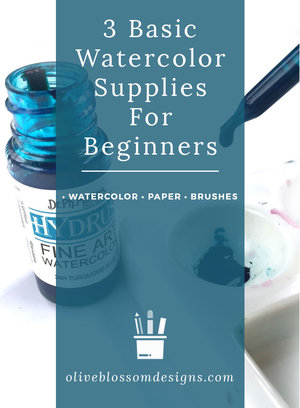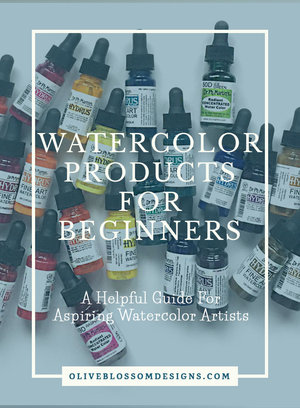Simple Watercolor Guide For Beginners - Supplies
*Disclosure - This post contains affiliate links. If you purchase something through a link, I may receive a commission at no extra charge to you. Thank-you
Watercolor Basics
Are you interested in watercolor but unsure how to get started or what materials to buy? I've been there, and, believe me, I know that it can be overwhelming. After all, there are tons of different supplies and techniques that watercolor artists use.
There are no set-in-stone rules in what materials to purchase. It is all a matter of the outcome you are going for and your personal preference and style.
This post is the first of a series covering watercolor basics. It will cover basic watercolor supplies, and the following posts will discuss watercolor techniques. My goal for this series is to provide detailed AND easy-to-follow information.
Let's get started!
Supplies
The basic supplies are:
Paint
Paper
Brushes
First up, paint!
Paint
For watercolor basics, paints are an obvious place to start. Watercolor paints come in different grades and forms.
The grade of paint describes the quality of the paint. Professional grades are more expensive and have more pigment than student grades. Professional grades are generally a better value since the color will go farther than student grades. It's good to experiment and see which you prefer.
Watercolor comes in the form of tubes, pans, or liquid concentrates.
Tubes
Tube watercolors have a creamy texture making it easy to blend.
Pans
Pans are solid and compact. They contain glycerin that makes them semi moist and easy to use. Pans come in full, half and quarter sizes.
Half Size Pan
Liquid Concentrates
Liquid watercolor contains highly concentrated pigment. A small amount goes a long way.
Take note that all brands of watercolor paint are not the same. For example, some indigo blues may have more, or less, blues, black, and purple pigments in different amounts. Even student and professional grade watercolors made by the same company can vary.
Paper
There are many types of watercolor paper, and the type you use determines the way watercolor pigments and how it can handle the amount of water used in a painting.
The fiber used in the watercolor papers are:
Cotton - Highest grade and made from 100% cotton
Cellulose - low - to mid-grade
Combination - a mixture of wood and cotton
Paper Weight
The higher the weight, the thicker and stiffer the paper. Watercolor paper generally comes in 90, 140, or 300 pounds. The most common being 140 lb.
Paper Finish
The fiber and weight of the paper are good to know information, but generally when shopping at a craft store, you'll find student grade paper in 140 lb and have the choice of the type of finish the paper will have. There are three types of watercolor paper finishes:
Hot Press - Smooth and hard, not very absorbent
Cold Press - Semi-rough, absorbent
Rough - Very rough and absorbent
* I had a hard time remembering the difference between Hot and Cold press paper, so I came up with a trick to help me. When you are COLD you get goose bumps making your skin bumpy/rough. Hence cold press is rough and HOT press is smooth.
Brushes
There are a bunch of different watercolor brushes out there. The basics of a watercolor brush are:
Fibers/Hairs
Shape
Size
Fibers
Natural Hair - Natural hair brushes hold the most water and are soft. The most common types of natural hair brushes are: camel, skunk, ox, goat squirrel and pony hair.
Synthetic - Synthetic brushes don't hold as much water or as soft as natural hair fibers. However, they watercolor holds together with less dissipation. Synthetic fiber brushes also are more firm and spring back into shape.
Sable/Synthetic Blend - A happy medium between the two is a mix. A Synthetic Blend holds adequate water and color, is soft and yet has the spring back and control of a synthetic brush.
Shape
The brush's shape determines the type of stroke or marks it will create. The basic shapes of brushes are:
Round - Very versatile. Stokes can range from thick to thin.
Flat - Angular and stiff.
Filbert - Useful for blending edges
Fan - Good for foliage and grass
Other shapes that are not pictured are:
Cat Tongue - filbert brushes with a point
Detail - Short tips brush for very tight details
Sword/dagger - able to create very wide to very thin stokes
Sizes
The brush's size comes into play by the amount of surface area you want to paint. If you have a huge area to paint, you'd want a larger brush. Using a small brush for larger areas to paint can cause the painting to look "overworked."
The most common sizes artists use are 6, 8, and 10 rounds.
For details, use smaller brushes.
Brush Handling and Care
Hold the brush as an extension of your hand. Grasp lower on the handle for more control and details.
















